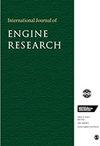冷却损失对基于两级可变增压、VVT 和 EGR 的重型柴油发动机能量和放能分布的影响
IF 2.1
4区 工程技术
Q2 ENGINEERING, MECHANICAL
引用次数: 0
摘要
废气再循环(EGR)与可变气门正时(VVT)和可变几何涡轮增压器(VGT)等机制的应用可以提高发动机效率;但由于EGR、VVT、VGT变化后的能量规律和损失分布不明确,制约了发动机结构的优化和相应策略的制定。本文以一台六缸发动机为研究对象,揭示了高压EGR回路的冷却损失是影响发动机能量分布的重要因素。冷却损失占总能量的10.00% ~ 20.00%,平均增长1.73%,超过其他能量损失增长率。低压EGR回路大大减少了冷却损失。当EGR率为20%时,低压EGR回路的冷却损失仅为高压EGR回路的64.05%。当EGR率>10%时,较低的冷却损失可有效提高发动机效率,低压EGR回路的指示热效率(ITE)比高压EGR回路高0.20% ~ 0.33%;当EGR率为21%时,LP EGR回路的ITE达到49.52%。通过研究火用随运行参数的变化,发现在EGR率从15%提高到20%的同时,将VVT调整到上死点后曲柄角- 85°(CA ATDC)或将VGT调整到原低速EGR回路(- 146°CA ATDC;vgt = 42.5%)。可用火用从71.22%增加到71.42%(- 146°CA ATDC;vgt = 42.5%;原始设备)至71.88%-71.58%(−146°CA ATDC;VGT = 47.5%)和72.02%-72.21%(−85°CA ATDC;vgt = 42.5%)。本研究探索了不同运行方案下的能量分布,为进一步提高整个装置的热效率提供理论指导。本文章由计算机程序翻译,如有差异,请以英文原文为准。
Influence of cooling loss on the energy and exergy distribution of heavy-duty diesel engines based on two-stage variable supercharging, VVT, and EGR
The application of mechanisms such as exhaust gas recirculation (EGR) coupled with variable valve timing (VVT) and a variable geometry turbocharger (VGT) can improve engine efficiency; however, the energy laws and loss distribution after EGR, VVT, and VGT changes are unclear, restricting the optimization of engine structures and corresponding strategies. Herein, a six-cylinder engine is studied, revealing that the cooling loss of the high-pressure (HP) EGR loop is an important factor affecting the engine energy distribution. The cooling loss accounts for 10.00%–20.00% of the total energy, with an average increase of 1.73%, surpassing other energy losses growth rates. The low-pressure (LP) EGR loop considerably reduces cooling losses. The cooling loss of the LP EGR loop is only 64.05% of the HP EGR loop at a 20% EGR rate. When the EGR rate is >10%, the resulting lower cooling losses effectively improve the engine efficiency and the indicated thermal efficiency (ITE) of the LP EGR loop is 0.20%–0.33% higher than that of the HP EGR loop; when the EGR rate is 21%, the ITE of the LP EGR loop reaches 49.52%. By studying the variation in exergy with operating parameters, it is found that while increasing the EGR rate from 15% to 20%, the proportion of available exergy increases by adjusting the VVT to −85° crank angle after top dead center (CA ATDC) or adjusting the VGT to 47.5% under the original operating scheme of the LP EGR loop (−146° CA ATDC; VGT = 42.5%). The available exergy increases from 71.22%–71.42% (−146° CA ATDC; VGT = 42.5%; original device) to 71.88%–71.58% (−146° CA ATDC; VGT = 47.5%) and 72.02%–72.21% (−85° CA ATDC; VGT = 42.5%). This study explores the energy distribution under different operating schemes, providing theoretical guidance for further improving the thermal efficiency of the entire device.
求助全文
通过发布文献求助,成功后即可免费获取论文全文。
去求助
来源期刊

International Journal of Engine Research
工程技术-工程:机械
CiteScore
6.50
自引率
16.00%
发文量
130
审稿时长
>12 weeks
期刊介绍:
The International Journal of Engine Research publishes high quality papers on experimental and analytical studies of engine technology.
 求助内容:
求助内容: 应助结果提醒方式:
应助结果提醒方式:


